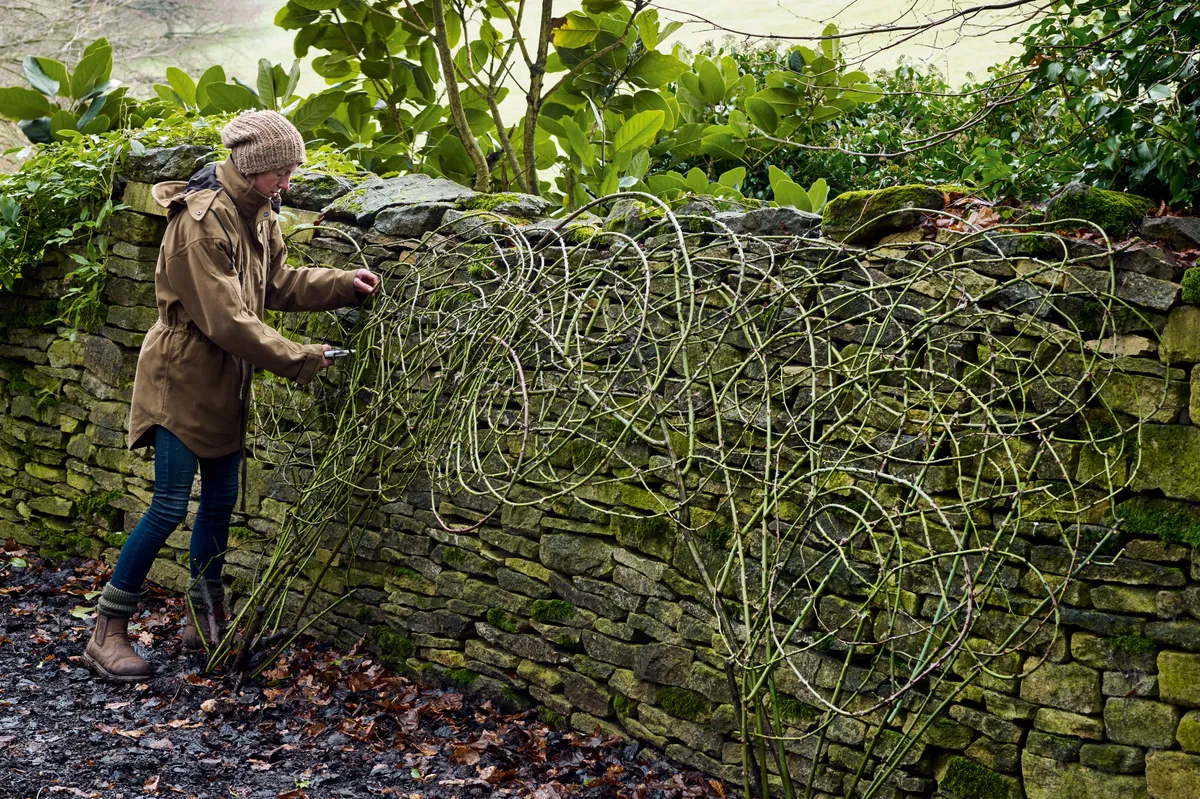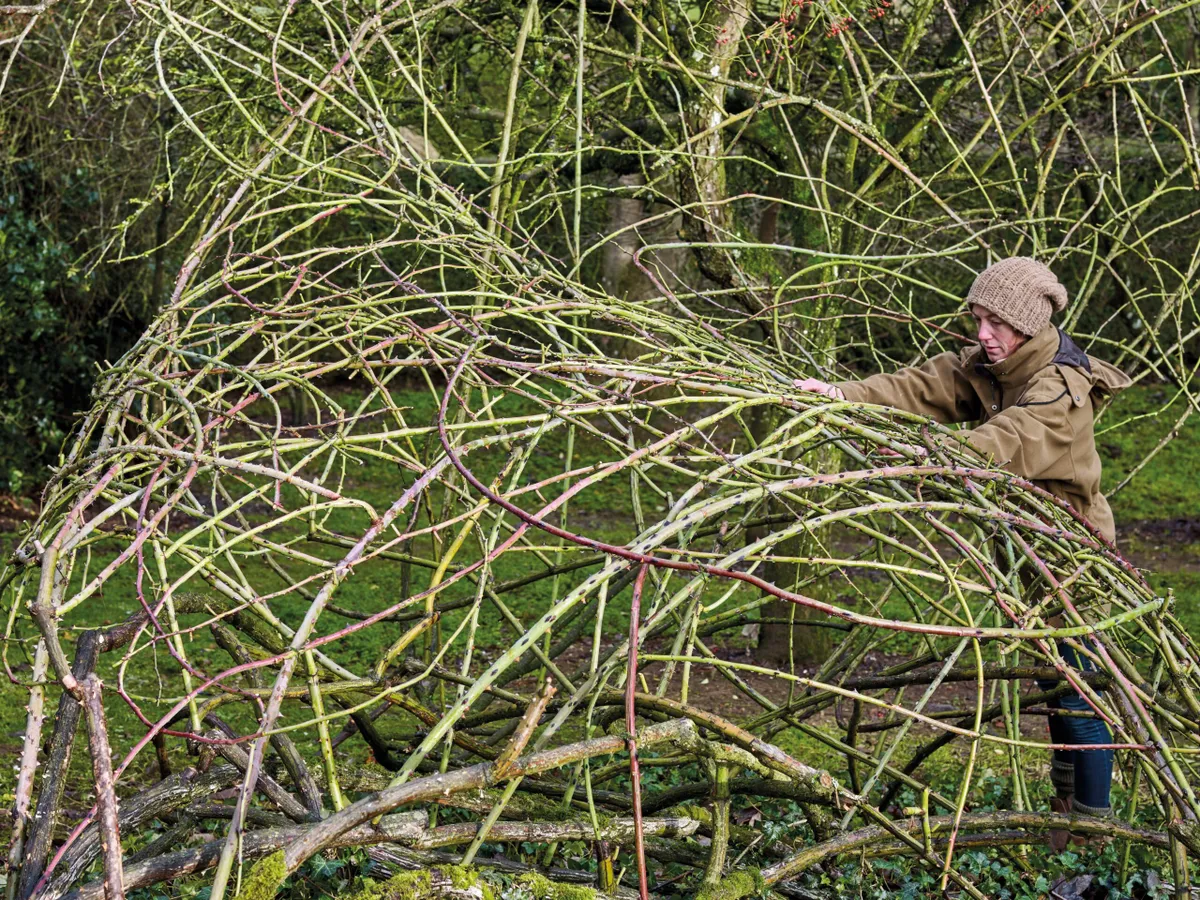Head gardener Jenny Barnes has turned rose training into an art form. She trains them in wonderfully imaginative ways along walls, creates free-standing rose domes and even trains them impressively through trees.
Here she shares her secrets to creating these beautiful living sculptures.
Here's how to train climbing roses
Rose training: how to train roses creatively
Training roses along walls

When training a rose on a wall, my aim is to cover as much of the surface as possible, creating a single-layer framework with evenly spaced stems. The simplest trained rose structures are both healthier and more aesthetically pleasing. The finished rose structure should be smooth, but by no means flat, a natural undulation occurs as the stems flex away from the wall, and back towards it, softening the sometimes harsh supporting structure.
The main rose stems are tied to wires on the wall, and subsequent stems are coaxed into complex curves and interwoven spirals. The rose is tied to itself, again and again, until a cage-like structure is formed. Patterns and shapes are created with the new stems, which add interest to a bare wall throughout the non-flowering period. You can also craft open spaces, or windows, in the design to form a focal point that draws the eye. The overall effect is one of neatness, structure and control, important in the winter months when there is little else to see. Come summer, the vigorous shoots break out from their constraints and the rose’s romance is returned.
3 of the best roses for wall training
Rosa ‘Albéric Barbier’
A large climber with clusters of incredibly pretty buttermilk buds opening to creamy-white flowers that look like crumpled tissues. New growth is slender and very supple making it particularly easy to train. Happy on a north-facing wall. 7m. AGM. RHS H5, USDA 5a-9b.
Rosa Malvern Hills (= ‘Auscanary’)
A healthy, mid-sized rose rambler that will quickly cover a wall with clusters of soft yellow flowers. Highly scented, it blooms consistently all summer and throws long, flexible new stems that are great for spiralling into creative shapes. 6m. RHS H5, USDA 5a-9b.
Rosa ‘Cécile Brünner’
A very vigorous, large rose climber producing masses of shaggy pink flowers for months on end. Its red-tinted stems create a stunning framework against paler stone. Evergreen in mild winters, which means slightly more work when pruning, but well worth the extra effort. 4m. AGM. RHS H5.
Here's more roses we love
Rose training into domes

I use roses as sculpture material, creating beautiful organic shapes that add to the garden regardless of the time of year. Depending on the rose you choose, these can be small, delicate, finely woven pieces or vast, bold, in-your-face statements. Whichever you create, a free-standing rose sculpture will add structure to your garden through the difficult winter months when borders have been cut down and much of the garden has been put to bed.
It is important to remember that when sculpting with roses, you can only work with what you have, the rose will guide you when creating your desired shape, do not go into it with a prefixed idea of what you want. Using the flexible new shoots, tie the stems to each other, criss-crossing and interlinking to create a strong, rigid frame. The rigidity will improve year on year. Organic, free-form shapes look best in a natural environment and I love to create balls, wrapping the long stems around each other to form a series of different-sized globes.
3 of the best roses for free-standing rose sculptures
Rosa ‘Paul’s Himalayan Musk’
One of my favourite roses to work with, producing an abundance of blush-pink flowers throughout the summer followed by bright-red hips. Masses of very long, new growth, which is perfect for manipulating into beautiful organic shapes. 5m. RHS H6, USDA 4a-9b.
Rosa ‘Madame Alfred Carrière’
An absolute dream of a rose to sculpt; virtually thornless, the stems are both strong and flexible, creating a sturdy framework to support the large, elegant, white blooms. Repeat flowering with a powerful fruity scent, this is a great all rounder. 6m. AGM. RHS H5, USDA 5a-9b.
Rosa ‘Zigeunerknabe’
Sometimes sold as ‘Gipsy Boy’, this large shrub rose has sprays of dark-crimson flowers. Flowers only once in early summer, but once trained, the glossy, dark-green foliage and thick stems create a fantastic structure with or without the flowers. I recommend for poor positions. 1.5m. RHS H7.
Here's more roses to buy and grow
Rose training in trees

Roses that are best suited to growing through trees tend to be the extremely large and very vigorous ramblers, as they need to be able to compete with the tree itself. Rambling roses, however, have a tendency to live up to their name, and there will eventually come a time when your rambling rose gets the better of whatever tree is supporting it – especially if that tree is relatively small – so rigorous pruning is imperative to keep it in check.
As they annually throw masses of very strong, flexible growth from the base, ramblers can very quickly become a tangled mass of stems, reaching for adjacent trees and shrubs and becoming tangled in long grass. However, it is this malleable new growth that I bend and twist, weaving it back up into the tree like a helix around a central core. You can then tie the stems along branches, so that the ends are allowed to hang down to create an umbrella-like effect, or coiled back up into globes hanging at different heights beneath the leaves.
3 of the best roses for training through shrubs and trees
Rosa filipes ‘Kiftsgate’
An absolute monster of a rose. Plant with caution as it’s huge, but if you have the space (and a well-established tree) then you can’t beat the clouds of fragrant, white flowers, followed by coral-red hips. Masses of exceptionally long, new growth from the base, so lots of artistic potential. 18m. AGM. RHS H6.
Rosa ‘Wedding Day’
An exceptionally large rambler, with numerous lemony-white, single flowers, the bees love it. With its dark, glossy foliage and tough, strong stems, it’s a great rose for creating extra-large sculptures. Big impact and maximum wow factor. 8m. RHS H6, USDA 4a-9b.
Rosa ‘Rambling Rector’
Another vigorous rambler providing heaps of supple, new growth, great for bending and shaping into works of art. Growth habit is a bit twiggy, so slightly more work to maintain a simple structure, but the resulting flowers – semi double, creamy white with a strong clove scent – are absolutely beautiful. 5m. AGM. RHS H6, USDA 4a-9b.